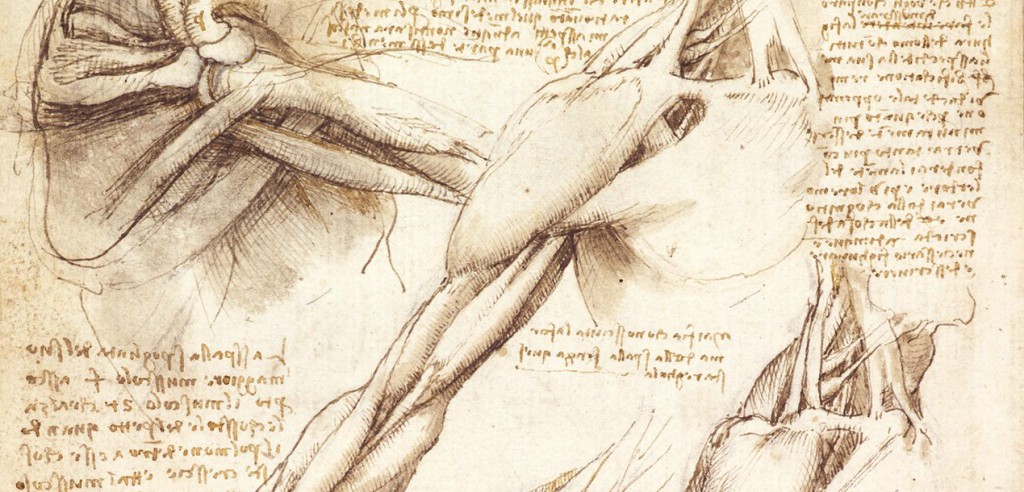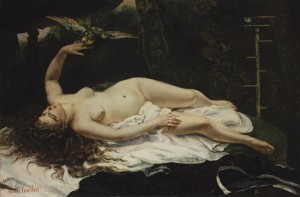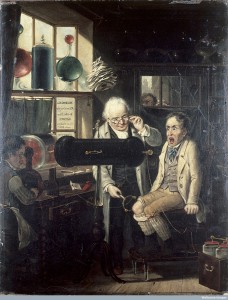Artist Carrie Mae Weems have appropriated Zealy’s photographs into monochrome red in her series “From Here I Saw What Happened and I Cried.” This monochrome red effect on the photographs amplifies the sadness of the history and the racism occurred at the time.Figures in the first four photos of the series were nude. Their emotionless facial expressions actually indicate that they have no power. In fact, they were objectified. They were granted no right to wear clothes in front of the camera. It disturbs me to see this series of photographs. The monochrome red effect makes me think of hatred. It also stimulates my anger. The caption in each photo further amplified the evidence of racism in Black in the history. This series show us the history of Black in the society dominated by the White. This shows how Black were treated inhumanely and unfairly. However, I think the texts give more meaning to the photos than the photos show us. If these photographs were narrated with medical diagnosis or information I believe the whole perspective would be shifted.
Monthly Archives: September 2015
Homework #2
I looked at the images before listening to the video. At first I began to look at each picture individually, while reading the text for each one. I was a bit confused with some of them. After I listened to the video, I went back and read all the texts straight through. It was as though a story was being told about the way they were mistreated and thought of as objects, and experiments rather than humans with rights. African Americans were given stereotypes and labels, rather than names and respect. The first and last 2 photos gave expressed the voice of the artist. The series is upsetting which is why the last photo says, “And I cried”. It is upsetting because I myself couldn’t imagine being treated as a label, as an experiment, having taken away my human rights and dignity. Being photographed topless, forced, and feeling uncomfortable is dehumanizing someone. I thought her work was very clever, and it makes everyone understand what was really going on. I myself am not artistic, so when looking at just photographs, it is a little bit more difficult to strip it apart and find its true meaning. When reading the captions, with the photo, it is similar to watching a movie where everything ties in.
Homework #2: Carrie Mae Weems on Race, Appropriation, and Photography
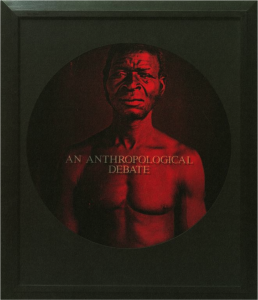
Carrie Mae Weems, “An Anthropological Debate” from “From Here I Saw What Happened and I Cried,” 1995-1996
In class we have studied J.T. Zealy’s daguerreotypes of slaves that were commissioned by Harvard scientist Louis Agassiz to support his belief in the theory of polygenesis. For this homework, please explore the works of contemporary artist Carrie Mae Weems, who uses the tool of appropriation to critique issues of race in her art. Appropriation is a popular practice for modern artists, who borrow and alter pre-existing images in order to transform and give images new significances. Weems appropriates many of Zealy’s photographs in her series “From Here I Saw What Happened and I Cried.” Listen to a brief statement about the series and explore the photographs in the series on her website. Reflect on your experience of reading the texts and looking at the images. Is it possible to do both at the same time? How would the work change without the text? What do you think of Weems’ photographic project?
Listen to Carrie Mae Weems on “From Here I Saw What Happened and I Cried”
Explore the “From Here I Saw What Happened and I Cried” series here
Please submit your post by class on Tuesday October 6th.
A birth scene. Oil painting by Abo.Sw
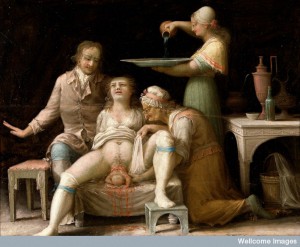
V0017247 A birth-scene. Oil painting by a French (?) painter, Åbo, Sw
Credit: Wellcome Library, London. Wellcome Images
images@wellcome.ac.uk
http://wellcomeimages.org
A birth-scene. Oil painting by a French (?) painter, Åbo, Sweden (later Turku, Finland), 1800.
1800 Published: –
Copyrighted work available under Creative Commons Attribution only licence CC BY 4.0 http://creativecommons.org/licenses/by/4.0/
This image displays a woman giving birth at home. The woman is sitting on a chair to give birth. The basket under the table, the lamp, chair indicates home. She is surrounded by a man who probably is her husband , an elderly woman woman who is playing the role of midwife and a female who appears to be pouring medicine. The male figure supports her back but appears to be scornful at the same time with his right hand flailed. Appears that he intends not to touch the blood or baby until cleaned up. The female appears to be in the final stage of labor, her cries seems lessened at this point as the head and arms of the baby are out the birth canal. The most painful stage. This image is similar to the images reviewed showing medical students the actual functions of the body, similar to Charles Etienne dissection of women. Shows the natural body functioning during birth. It is striking that a male is witnessing the birthing process and actually participating . This to me would be considered a more modern role. I thought the birthing process would be handled by women only then. This picture strongly depicts a woman’s strength. He lower body is strongly build and is ready for the birthing role.
Woman with a Parrot
“Woman with a Parrot” was painted in 1866 by Gustave Courbet. It is oil on canvas with the dimensions fifty one inches by seventy seven inches. Courbet was a French painter and “Woman with a Parrot” was originally painted for the Salon. It was housed there and then ended up in the H.O. Havemeyer collection until 1929 when it was donated to the Metropolitan Museum of Art in New York City where it remains to this day.
The image is a painting. It has a large central figure and a small peripheral figure. The central figure is that of a nude woman. The woman is reclining on her back with the top of her head pointing towards the bottom of the picture. The woman is Caucasian and has pale skin. Her primary sexual organs are covered by a white cloth though her breasts are uncovered. Her breasts are on the smaller side of average. She has thick, heavy eyebrows, but no pubic hair. She has a very slight paunch on her lower stomach. Her hands are delicate. Her left hip is raised while her right hip is flat. She is lying on a green velvet day bed that is partially covered by a white cloth; said cloth reflects white light up against her splayed legs. Her knees are bent; her right leg extended forward, her left is back. Her right hand is resting on her right leg, her while her left arm is extended in the air. The image is sensual, but not sexual.
On the central figure’s left hand is perched our peripheral figure. A large colorful bird that based on the title- must be a parrot. The bird has a small curved beak. Over its beak is a splotch of blue. Above the blue it is yellow; the bird’s breast is yellow too. The back and wings are a muted grayish green with orange, yellow and blue highlights. The wings are spread, the head faces down towards the bottom of the painting. The tail is the same mix of colors as the wings and points towards the upper left hand corner of the painting. The bird looks as if it has just landed and its claws encircle the woman’s left forefinger.
The background is dark and muted. A tall stand with several horizontal bards is behind the right corner of the day bed. The viewer can assume that this is a perch for the parrot. It is an ambiguous grayish brown that could be wood or tarnished metal. Behind that hangs a dark, but richly patterned cloth and in the far back ground seems to be trees and a sky.
The way that the parrot is placed on the woman’s hand, the angle of its head in relation so her head suggests interaction. The woman smiles up at the bird. In my opinion she looks slightly delirious, as if she has a fever or is on drugs. She is nude, never uncommon in art, but it may suggest that she isn’t thinking clearly. Moreover, beyond artistic expression, why is a woman in a fairly conservative time lounging nude with a bird? Birds are known carriers for disease. From a simple hygienic stand point, I can say that I would never be naked around a bird because of the propensity to defecate everywhere. So is the woman feverish? Is she high? Does she suffer from some mental illness? Or is it simply a romantic artistic choice? The woman has ruddy cheeks but a pale body, heavy eyebrows but no other body hair. Any of these things could point to an illness, but more likely they are all fanciful artistic choices. Certainly if I had not been looking at this image for this class it never would have occurred to me that it is medical in nature.
Homework #1

The image I chose was of a woman holding a young boy receiving an injection. The people in the picture look like they are at home in their living room. The family doctor has stopped by to give the child the shot. The young boy is sitting on it’s mother’s lap while the doctor inoculates the child. Two other children look on at the doctor. A boy looks on while holding the back of the doctor’s chair. A girl looks on from the other side of the doctor and holds a basket behind her back. The artist uses tenebroso in this picture. The background surrounding the people is dark while a strong light shines in on this family and doctor. You can’t make out the surrounding objects in the far background. To the side of the people is a child’s crib. I chose this picture because vaccinations happen to be a very important part of living. In earlier times, things were done differently. Instead of people traveling to a doctor’s office to receive care, doctor’s would travel to their patient’s home. In this instance, the doctor has traveled to this family’s home. He could be there to administer medication to the child because he was sick or they were trying to prevent sickness. The children and mother all look on in awe.
Welcome Home HW # 1
The image that I chose is “interior with a surgeon attending to a man’s wound”. I picked this particular image because of the palpable emotions display throughout the scene. I see fear and uncertainty. There is a sea of urgency coupled with a need of reassurance that everything is going to be fine. I can feel the pain and the anguish in the eyes of the victim and in those present around him. The patient in this image is hollowing with extreme pain and discomforts which literally prevent him to remain still on the chair as the surgeon is attending to his wound. Even the animal in the image seems to be disturbed by the enormity of the situation. The doctor seems to be calm and collected, as it is to be expected and so is a male nurse who seems to be assisting him.
Across the room, there is a woman sitting on a chair, who is unable to control her emotions. She looks very distressed and saddened by the situation. Further right, there are two men, standing by the door’s entrance and they have a look of concern in their eyes, and so is the man standing closer by the dog, as he remains discombobulated by the whole incident. Moreover, the background in the image is very captivating. It looks like a well maintained house, reminiscent of an old country home, or those similar in a scene of an old Western movie on TV. There is adequate lighting in the image, which can help the surgeon while he is covering the man’s wound.
A key similarity that exists in this image and those exposed in class, is the lighting and a well maintained area, plus a myriad of emotions that are easily able to discern due to the apparent circumstances.
Home Work #1
My picture, although not as explicit as some we’ve seen in class. It involves electroshock therapy. Although this is a more modern painting than what we saw in class, It still serves as historical medical record. Electroshock was a treatment used in thr late 19th and early 20th centuries to treat a number of ailments. In the painting, the patient’s face is what originally drew me to it. He seems to be in incredible pain, where as the doctor is very nonchalantly applying the treatment. They are clearly meant to be the focal point of the painting as they are direclty lit from the window. Upon further inspection you can see a looker-in through a back window of what I could only guess was an alleyway doctor’s office. What really got me was the sadistic face of the doctor’s helper. He is smiling as he cranks the generator. He seems to be enjoying the pain of by the patient, and glad he is the one to deliver the power for it.
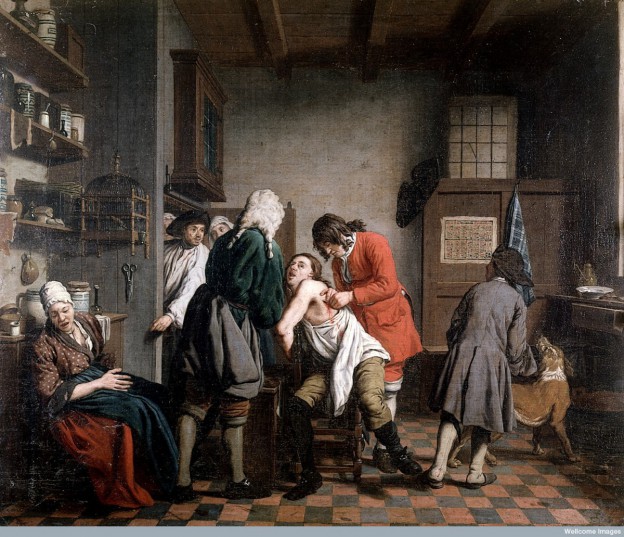
Homework #1 Michael Estrada
What I have found striking of this image was , how the patience in this image is being treated. it reflects how medicine has been improved over time. It got my attention because this image shows someone having a surgery . I think it was a common act where the surgeon did not have a specific place where to do this surgery or the patient could go like a hospital or a right place to do the surgery. We can also see the lack of hygiene during a clinical surgery, as we see there is a dog being walking around which might represent the lack of cleanliness and a mother or wife who suffers of pain more than a man who is being treated maybe with no anesthesia at all . It also shows a surgeon with no glove or special tools for doing a well surgical process as now days. I am seeing someone putting its own hand in a open wound trying to move or find something inside the patient. This image shows same contrast, feelings and reality as the images seen in class. through this master piece of drawing we can see how the history of medicine has been improved since long time ago where there was no camera of any relating media as there are plenty of them today.
Homework #1
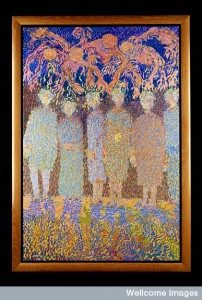
L0032442 CARSON: Patients waiting to see doctor
Credit: Carson, Rosemary/The Wellcome Library, London. Wellcome Images
images@wellcome.ac.uk
http://wellcomeimages.org
Patients waiting to see the doctor, with figures representing their fears.
Oil
4e/62/1997 By: Rosemary CarsonPublished: 1997.
Copyrighted work available under Creative Commons Attribution only licence CC BY 4.0 http://creativecommons.org/licenses/by/4.0/
This image stood out to me because of the first top half of the image. This image is a little different than what we’ve been looking at in class so far. This is an oil painting that at first glance the images look like demons or some kind of evil spirits. The artist painted them in red which is what stuck out to me. Upon reading the title, the image made perfect sense to me. It is titled “Patients waiting to see doctor”. These figures are suppose to represent their fears which is an awesome image to me. The people in the image aren’t clearly drawn. There are no facial features, on any of the humans, but you can see some features on the “fears” floating above.
I think people do feel like this when they go to the doctor, which is why many people don’t visit the doctor as frequently as they should. They fear what the outcome of the experience might be. I think this image is a perfect representation of how many people feel and the anxiety they experience .
